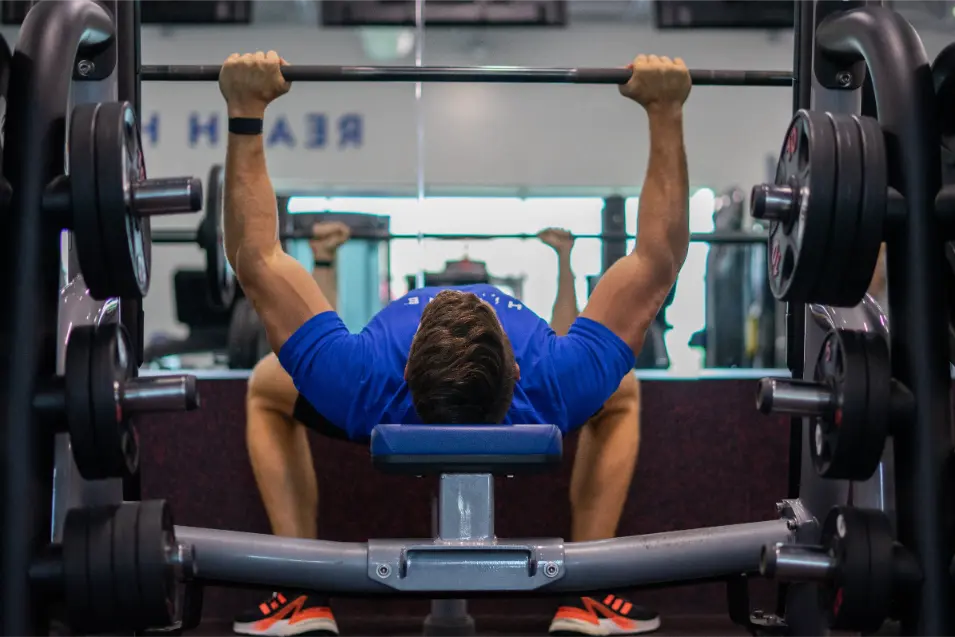We all know that stepping into the world of weight lifting can be a bit daunting. Pumping iron isn’t just about throwing around heavy weights at random. It’s a calculated, disciplined practice that requires a well-thought-out plan. Wandering aimlessly around the gym, jumping from one machine to another, without a clear idea of what you hope to achieve, is a one-way ticket to failure. Even worse, it can lead to overtraining, causing nasty injuries that can sideline you for months.
That is why we’re going to break down the basics of weight lifting schedules for beginners and help you get started on the right foot. No more confusion, no more guesswork. Just clear, concise, and actionable advice to get you from ‘zero’ to ‘hero’.
The best weight lifting schedules for beginners
When you’re just starting out, your primary focus should be on mastering the basics. That’s right, no fancy, convoluted exercises. Instead, you should be concentrating on those essential lifts – squats, deadlifts, bench presses, overhead presses, and rows. These exercises are the bread and butter of any successful weight lifting regimen and will lay a solid foundation for your fitness journey.
Now, perfect form is the key to effective lifting and long-term progress. It ensures that you’re engaging the right muscles, reducing the risk of injury, and getting the most out of each rep. There’s nothing more counterproductive than hoisting up a heavy weight with poor form. Not only does it set you up for potential injuries, but it also means you’re not working your muscles effectively.
When it comes to scheduling your workouts, balance is key. Your body is a complex system, and every part plays an essential role. So, don’t be that guy who only trains his upper body and neglects his legs. Aim to work all your muscle groups evenly. This way, you’ll develop a well-rounded physique and avoid imbalances that can lead to injuries.
Now, onto the question of splits. As a beginner, you can choose any split that you feel comfortable with. The most important thing is that you enjoy your workouts and feel motivated to stick to your schedule. However, to give you a head start, here are a couple of splits that work well for beginners:
- Full Body Split: This involves working all your major muscle groups in a single workout. You could perform this routine 3 times a week, ensuring you’re hitting each muscle group frequently.
- Upper/Lower Split: This split divides your workout into two sessions – one focusing on upper body exercises and the other on lower body exercises. You can perform this routine 4 times a week, alternating between upper and lower body workouts.
- Push/Pull/Legs Split: This split divides your workout into three sessions – one focusing on push movements (chest, shoulders, and triceps), one on pull movements (back and biceps), and one on legs. You can perform this routine 3-6 times a week, depending on your recovery ability.
What exercises should you focus on?
When you’re just starting out, it’s tempting to try every exercise you see on social media or in the gym. However, it’s essential to stick to the basics first. Here, I’ll break down the most effective exercises for each major muscle group:
Chest
Your primary focus here should be the Bench Press. This compound exercise targets your chest, but also works your shoulders and triceps. Start with the bar to get a feel for the movement before adding weight. Incline and decline variations can also be incorporated for a comprehensive chest workout.
Back
The king of all back exercises is the Deadlift. It not only strengthens your back, but also works your entire body. Start with light weights and focus on your form. Other effective back exercises include Bent-Over Rows and Lat Pulldowns.
Shoulders
For shoulders, you can’t beat the Overhead Press. This exercise targets your entire shoulder region and also engages your core. Start with dumbbells before moving on to a barbell. Lateral Raises are also excellent for working the side deltoids.
Legs
Squats are the go-to exercise for your legs. They work your quads, hamstrings, and glutes. As with all exercises, start with light weights and perfect your form before adding more weight. Lunges and Leg Presses are also great for targeting your lower body.
Arms
For your biceps, the classic Dumbbell Curl is a great starting point. For triceps, the Tricep Dips and Pushdowns are highly effective. Remember, your arms are also worked during compound movements like presses and rows, so there’s no need to overdo it with isolation exercises.
Core
Planks are a simple but effective exercise for strengthening your core. They work your entire midsection and also improve your stability and posture. Other good core exercises include Crunches and Russian Twists.
How to adjust weight lifting schedules based on your fitness goals?
We all have different fitness goals. Some of us want to bulk up and build muscle, while others might be aiming to lean down and tone up. That’s the beauty of weight lifting – it can be tailored to suit a wide range of goals. Here’s how you can adjust your weight lifting schedule based on what you want to achieve:
Muscle building
If your goal is to pack on muscle, you’ll want to focus on lifting heavier weights with lower reps. A typical workout might involve 3-5 sets of 6-8 reps with a weight that challenges you. Rest periods between sets should be longer (around 1-2 minutes) to allow for full recovery. Prioritize compound exercises like squats, deadlifts, and bench presses, as these engage multiple muscle groups and promote muscle growth.
Fat loss
If you’re aiming to shed fat, your weight lifting schedule should involve higher rep ranges with lighter weights. This could mean doing 3-4 sets of 12-15 reps with a weight that’s challenging but manageable. Rest periods should be shorter (around 30-60 seconds) to keep your heart rate up and burn more calories. Incorporating a mix of compound and isolation exercises can help maximize fat loss.
Strength gain
If you’re looking to get stronger, your focus should be on lifting very heavy weights for fewer reps. This might involve doing 5 sets of 5 reps with a weight that’s close to your maximum. Rest periods should be longer (2-3 minutes) to allow for maximum strength recovery between sets. Compound exercises are key here, as they allow you to lift heavier weights and work multiple muscles at once.
Muscle tone
If you’re aiming for a toned, defined look, your weight lifting schedule should involve a mix of moderate weights and higher reps. This might mean doing 3-4 sets of 10-12 reps with a weight that’s challenging but manageable. Rest periods should be moderate (60-90 seconds) and your workout should include a mix of compound and isolation exercises for comprehensive muscle development.
Is it smart to work with a personal trainer as a beginner?
So, you’re just starting out on your weightlifting journey and you’re wondering if hiring a personal trainer is a smart move? The short answer is – absolutely! Here’s why:
Mastering the basics
As we’ve stressed throughout this guide, mastering proper form is critical when you’re starting out. A personal trainer can guide you through each exercise, ensuring that you’re performing it correctly and safely. This hands-on approach can be a game-changer in helping you build a solid foundation.
Personalized plan
Everyone’s body is different, and what works for one person might not work for another. A personal trainer can create a customized workout plan that aligns with your fitness goals, taking into account your current fitness level, any pre-existing injuries, and your personal preferences.
Motivation and accountability
Let’s face it, we all have days when we’re less motivated to hit the gym. Having a personal trainer can provide that extra push you need to stay consistent. They hold you accountable, ensuring you’re not skipping workouts and you’re sticking to your plan.
Progress tracking
A personal trainer will track your progress over time, making necessary adjustments to your workout plan to ensure you’re continually progressing towards your goals. This can prevent plateaus and keep your workouts challenging and exciting.
Injury prevention
Injuries can be a major setback in your fitness journey. A personal trainer can teach you the correct techniques and form to help minimize the risk of injuries.
Final thoughts
Remember, the most important thing is to start with the basics, prioritize form over weight, and take it one rep at a time. Rome wasn’t built in a day, and neither will your dream physique. It’s all about consistent effort, patience, and a whole lot of determination.
Consider working with a personal trainer if you can – they can be an invaluable resource in helping you navigate the weight room, master your form, and stay motivated. But most importantly, listen to your body and make adjustments as needed.







